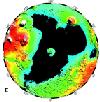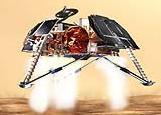 December 31:
December 31:
Astrobiologists will send bacteria into space and back inside manmade "meteorites" attached to the heat shield of a Russian space probe to test whether germs inside meteorites from Mars could have survived a journey to Earth. The launch is planned for 27 January, 2000. A preliminary experiment without bacteria took place in September. The experimental group is led by Dr. André Brack, of the Centre de Biophysique Moleculaire, Orleans, France.
 Bugs in space, by Laura Miles, BBCNews Online, 30 December 1999.
Bugs in space, by Laura Miles, BBCNews Online, 30 December 1999.
 Life on Mars! is a related CA webpage.
Life on Mars! is a related CA webpage.
December 30:
British scientists plan astrobiology forum — "The scientists want the publicity in the hope it will get them some money."
 Hunting for ET, by David Whitehouse, BBCNews Online, 13 December 1999.
Hunting for ET, by David Whitehouse, BBCNews Online, 13 December 1999.
 There’s Something Out There, ABCNEWS.com, 13 December 1999.
There’s Something Out There, ABCNEWS.com, 13 December 1999.
 December 26:
December 26:
Our perspective on the dispute between evolution and creationism is rare — we have major disagreements with both sides. While we align with science, we think creationists make some valid points in this debate, as Christian philosopher William A. Dembski does in his new book, Intelligent Design. His crucial concept is "complex specified information" (CSI), explained here to the general public. "What randon typing cannot do is produce an extended meaningful text that is both complex and specified" (p 166). He goes on to quantify "complex" as requiring at least 500 bits of information. (That's 250 DNA nucleotides). We wish that Dembski, with PhDs in mathematics and philosophy, would pursue this argument further. We wish he could define CSI in a way that would permit decisive experiments in computer models.
Instead, Intelligent Design is mainly standard creationist rhetoric. This includes reinforcing the gridlock between evolution and creationism: "There are but two options...." And it includes an attack on scientific method. Creationists call it "naturalism," about which Dembski writes, "...For the sake of inquiry we are required to pretend that God does not exist." Almost all active scientists accept this approach. But Dembski wants to know, "How then do we defeat naturalism?" (p 103).
Unfortunately, Dembski's "we" refers not to scientists, nor to the interested public, but to Christian fundamentalists. The book even has a subchapter entitled "Christ as the Completion of Science." Of course, few scientists will read it and the gridlock between evolution and creationism will not be weakened. Too bad for the interested public.
 William A. Dembski, Intelligent Design: The Bridge Between Science & Theology, InterVarsity Press, 1999.
William A. Dembski, Intelligent Design: The Bridge Between Science & Theology, InterVarsity Press, 1999.
 Evolution vs Creationism is a related CA webpage.
Evolution vs Creationism is a related CA webpage.
 December 23, 1999:
December 23, 1999:
Lord Kelvin's address to British scientists, in 1871, made the case that life on Earth may well have come from space. "When a volcanic island springs up from the sea, and after a few years is found clothed with vegetation, we do not hesitate to assume that seed has been wafted to it through the air, or floated to it on rafts. Is it not possible, and if possible, is it not probable, that the beginning of vegetable life on the Earth is to be similarly explained? Every year thousands, probably millions, of fragments of solid matter fall upon the Earth...."
 Report of the Forty-First Meeting of the British Association for the Advancement of Science, Edinburgh, 1871, London, 1872, posted on Internet Archive. Search for "The essence of science" or "When a volcanic island".
Report of the Forty-First Meeting of the British Association for the Advancement of Science, Edinburgh, 1871, London, 1872, posted on Internet Archive. Search for "The essence of science" or "When a volcanic island".
 On The Origin Of Life, two-page excerpt from Kelvin's Popular Lectures and Addresses,
On The Origin Of Life, two-page excerpt from Kelvin's Popular Lectures and Addresses,
 Introduction... is a related CA webpage.
Introduction... is a related CA webpage.
 The RNA World is about origin-of-life theories.
The RNA World is about origin-of-life theories.
 The End and the Big Bang discusses Kelvin.
The End and the Big Bang discusses Kelvin.
December 16:
AGU says Europa looks good for life— At a meeting of the American Geophysical Union, Richard Greenberg of the Lunar and Planetary Laboratory at the University of Arizona-Tucson said that recent photographs of Europa show a "clement and comfortable" world where microorganisms may well have taken hold.
 Europa environment 'conducive to life', CNN.com, 16 December 1999.
Europa environment 'conducive to life', CNN.com, 16 December 1999.
 Life on Europa... has links to WhatsNEW on Jupiter's and other moons.
Life on Europa... has links to WhatsNEW on Jupiter's and other moons.
December 14:
Meet Conan the Bacterium — NASA promotes Deinococcus radiodurans as capable of being genetically engineered to terraform Mars.
 Humble microbe could become "The Accidental (Space) Tourist", by Dave Dooling, NASA MSFC, 14 December 1999.
Humble microbe could become "The Accidental (Space) Tourist", by Dave Dooling, NASA MSFC, 14 December 1999.
 Bacteria: The Space Colonists is a related CA webpage.
Bacteria: The Space Colonists is a related CA webpage.
 December 10:
December 10:
Microbes living deep in million-year-old ice in Antarctica — Multi-disciplinary teams found bacteria similar to Proteobacteria and Actinomycetes above Lake Vostok in ice two miles deep, where the pressure is about 350 times greater than at sea level. "Microbes within a liquid water habitat deep below a frozen surface provide an analog for possible life on Europa," they comment.
 Priscu, John C.; Edward E. Adams; W. Berry Lyons; Mary A. Voytek; David W. Mogk; Robert L. Brown; Christopher P. McKay; Cristina D. Takacs; Kathy A. Welch; Craig F. Wolf; Julie D. Kirshtein and Recep Avci, "Geomicrobiology of Subglacial Ice Above Lake Vostok, Antarctica," p 2141-2144 v 286 Science, 10 December 1999. [abstract]
Priscu, John C.; Edward E. Adams; W. Berry Lyons; Mary A. Voytek; David W. Mogk; Robert L. Brown; Christopher P. McKay; Cristina D. Takacs; Kathy A. Welch; Craig F. Wolf; Julie D. Kirshtein and Recep Avci, "Geomicrobiology of Subglacial Ice Above Lake Vostok, Antarctica," p 2141-2144 v 286 Science, 10 December 1999. [abstract]
 Karl, D. M.; D. F. Bird; K. Björkman; T. Houlihan; R. Shackelford and L. Tupas, "Microorganisms in the Accreted Ice of Lake Vostok, Antarctica," p 2144-2147 v 286 Science, 10 December 1999. [abstract]
Karl, D. M.; D. F. Bird; K. Björkman; T. Houlihan; R. Shackelford and L. Tupas, "Microorganisms in the Accreted Ice of Lake Vostok, Antarctica," p 2144-2147 v 286 Science, 10 December 1999. [abstract]
 Exotic Microbes Discovered near Lake Vostok, NASA Marshall Space Flight Center, 10 December 1999.
Exotic Microbes Discovered near Lake Vostok, NASA Marshall Space Flight Center, 10 December 1999.
 Antarctica's frozen slice of life offers clues to life elsewhere, NASA Newsrelease 99-81AR, by Kathleen Burton, Ames Research Center, 10 December 1999.
Antarctica's frozen slice of life offers clues to life elsewhere, NASA Newsrelease 99-81AR, by Kathleen Burton, Ames Research Center, 10 December 1999.
 Microbes found deep in Antarctic ice, by Alan Boyle, MSNBC, 9 December 1999.
Microbes found deep in Antarctic ice, by Alan Boyle, MSNBC, 9 December 1999.
 Antarctic Discovery Supports Possibility of Life on Europa, SpaceViews, 13 December 1999.
Antarctic Discovery Supports Possibility of Life on Europa, SpaceViews, 13 December 1999.
 "Exploring Lake Is Like Visiting Another Planet," The New York Times, 14 December 1999. [text]
"Exploring Lake Is Like Visiting Another Planet," The New York Times, 14 December 1999. [text]
 Bacteria: The Space Colonists is a related CA webpage.
Bacteria: The Space Colonists is a related CA webpage.
 December 10:
December 10:
Minimal life requires about 300 genes — This is the conclusion of a team from The Institute for Genomic Research (TIGR) that examined the smallest known bacterium, Mycoplasma genitalium. Disabling its 480 protein-encoding genes one by one, they found that most of them, including about 100 with unknown functions, are essential. While publicists are speculating mostly about science's increased ability to manipulate life, one of the researchers, Craig Venter, says the work may also help explain the origin of life. We will watch for any progress on this subject. Meanwhile, the results indicate that the simplest viable cell is still quite complex.
 Hutchison, Clyde A. III; Scott N. Peterson; Steven R. Gill; Robin T. Cline; Owen White; Claire M. Fraser; Hamilton O. Smith; J. Craig Venter, "Global Transposon Mutagenesis and a Minimal Mycoplasma Genome," p 2165-2169 v 286 Science, 10 December 1999. [abstract]
Hutchison, Clyde A. III; Scott N. Peterson; Steven R. Gill; Robin T. Cline; Owen White; Claire M. Fraser; Hamilton O. Smith; J. Craig Venter, "Global Transposon Mutagenesis and a Minimal Mycoplasma Genome," p 2165-2169 v 286 Science, 10 December 1999. [abstract]
 Is life just genes?, by David Whitehouse, BBC News Online, 10 December 1999.
Is life just genes?, by David Whitehouse, BBC News Online, 10 December 1999.
 Scientists call for life creation debate, by David Whitehouse, BBC News Online, 10 December 1999.
Scientists call for life creation debate, by David Whitehouse, BBC News Online, 10 December 1999.
 Creating artificial bugs, by Andrew Luck-Baker, BBC News Online, 24 January 1999.
Creating artificial bugs, by Andrew Luck-Baker, BBC News Online, 24 January 1999.
 300 Essential Genes in Bugs, ABCNews, 9 December 1999.
300 Essential Genes in Bugs, ABCNews, 9 December 1999.
 UNC-CH scientist finds smallest number of genes needed for organism’s survival, by David Williamson, UNC-CH News Services, 9 December 1999.
UNC-CH scientist finds smallest number of genes needed for organism’s survival, by David Williamson, UNC-CH News Services, 9 December 1999.
 Wade, Nicholas, "Life Is Pared to Basics. Complex Issues Arise," The New York Times, 14 December 1999. [text]
Wade, Nicholas, "Life Is Pared to Basics. Complex Issues Arise," The New York Times, 14 December 1999. [text]
 What Is Life? is a related CA webpage.
What Is Life? is a related CA webpage.
 December 10:
December 10:
More evidence for past ocean on Mars — Planetary geologists examined six categories of data from the Mars Global Surveyor and concluded that Mars had an ocean. Likely ancient shorelines show evidence of wave action and smooth regions at lower elevations resemble sedimented seafloors. This idea was considered "wild" only a decade ago.
 Head , James W. III; Harald Hiesinger; Mikhail A. Ivanov; Mikhail A. Kreslavsky; Stephen Pratt and Bradley J. Thomson, "Possible Ancient Oceans on Mars: Evidence from Mars Orbiter Laser Altimeter Data," p 2134-2137 v 286 Science, 10 December 1999. [abstract]
Head , James W. III; Harald Hiesinger; Mikhail A. Ivanov; Mikhail A. Kreslavsky; Stephen Pratt and Bradley J. Thomson, "Possible Ancient Oceans on Mars: Evidence from Mars Orbiter Laser Altimeter Data," p 2134-2137 v 286 Science, 10 December 1999. [abstract]
 Broad, William J., "Tantalizing Signs of Ancient Martian Ocean," The New York Times, 10 December 1999. [text]
Broad, William J., "Tantalizing Signs of Ancient Martian Ocean," The New York Times, 10 December 1999. [text]
 Reichhardt, Tony, "Opinion divided on images of Martian 'ocean'," p 452 v 402, Nature, 2 December 1999.
Reichhardt, Tony, "Opinion divided on images of Martian 'ocean'," p 452 v 402, Nature, 2 December 1999.
 Brown geologist finds evidence supporting ancient ocean on Mars, Brown University News Release 99-060, by Janet Kerlin, 9 December 1999.
Brown geologist finds evidence supporting ancient ocean on Mars, Brown University News Release 99-060, by Janet Kerlin, 9 December 1999.
 Life on Mars! is a related CA webpage.
Life on Mars! is a related CA webpage.
December 7:
Germ-line transmission of transgenes — Embryologists at the Carnegie Institution of Washington inserted "transgenes" into frogs and bred them to see if new lines of frogs could be established that way. One hundred percent of the adult frogs parented progeny that carried the transgenes. Apparently, genes acquired by mature creatures may become permanently installed into their descendants' genomes more readily than once supposed.
 Marsh-Armstrong, Nicholas; Hoachu Huang; Deborah L. Berry and Donald D. Brown, "Germ-line transmission of transgenes in Xenopus laevis," p 14389-14393 v 96 n 25, Proc. Nat. Acad. Sci. USA, 7 December 1999. [abstract]
Marsh-Armstrong, Nicholas; Hoachu Huang; Deborah L. Berry and Donald D. Brown, "Germ-line transmission of transgenes in Xenopus laevis," p 14389-14393 v 96 n 25, Proc. Nat. Acad. Sci. USA, 7 December 1999. [abstract]
 Viruses... is a related CA webpage. [Next-What'sNEW about HGT-Prev]
Viruses... is a related CA webpage. [Next-What'sNEW about HGT-Prev]
December 7:
Are Martians Dangerous? — The debate about the danger posed by germs in returned martian soil continues. We notice in passing that the possibility of interplanetary panspermia has now become entirely acceptable. "Despite the fact that in general each such meteorite must wander through space for millions of years before reaching earth, it is the opinion of experts that neither this period traveling through hard vacuum, nor the trauma associated with either the initial ejection from Mars or entry at Earth, would have been sufficient to sterilize these objects if they had contained bacterial spores. It has been estimated that these Martian rocks continue to rain down upon the Earth at a rate of about 500 kilograms per year," says Robert Zubrin, author of The Case for Mars.
 Mars Invades Earth, by Bruce Moomaw, SpaceDaily, 7 December 1999.
Mars Invades Earth, by Bruce Moomaw, SpaceDaily, 7 December 1999.
 Is Biohazard Level 4 Enough?, by Barry E. DiGregorio, SpaceDaily, 8 December 1999.
Is Biohazard Level 4 Enough?, by Barry E. DiGregorio, SpaceDaily, 8 December 1999.
 Life on Mars! is a related CA webpage.
Life on Mars! is a related CA webpage.
 December 5:
December 5:
Silence from Mars Polar Lander. The spacecraft approached Mars without any apparent problems on Friday, December 3, but failed to send a signal after it entered its landing sequence. On Sunday morning, NASA still hopes that a signal relayed via the orbiting Mars Global Surveyor will be received.
 Mars Polar Lander homepage at NASA, JPL.
Mars Polar Lander homepage at NASA, JPL.
 Silent Mars, ABCNews.com, 5 December 1999.
Silent Mars, ABCNews.com, 5 December 1999.
 News from Mars, from The Astrobiology Web: lotsa links, updates often.
News from Mars, from The Astrobiology Web: lotsa links, updates often.
 The Fear Of A "Non-Upright Touchdown", by Bruce Moomaw, SpaceDaily, 17 November 1999.
The Fear Of A "Non-Upright Touchdown", by Bruce Moomaw, SpaceDaily, 17 November 1999.
 Wilford, John Noble, "Scientists Scramble to Restore Signals to Martian Mission," The New York Times, 5 December 1999.
Wilford, John Noble, "Scientists Scramble to Restore Signals to Martian Mission," The New York Times, 5 December 1999.
In addition to searching for water, the mission could answer a question lingering since 1976-1977, after the Viking probes' life-detecting experiments came back positive. NASA ultimately announced that the positive results for the "Labeled Release" experiment were caused by hydrogen peroxide in Mars' soil. A new "Thermal Evolved Gas Analyzer" (TEGA) on the Mars Polar Lander would be able to detect hydrogen peroxide, if it is there. We hope the mission is not lost. (Thanks Barry DiGregorio for alerting us about TEGA.)
 Will NASA Unwittingly Confirm Life on Mars (background on TEGA written before the communication failure) by Gil Levin for Space News, 6 December 1999.
Will NASA Unwittingly Confirm Life on Mars (background on TEGA written before the communication failure) by Gil Levin for Space News, 6 December 1999.
 Martian mysteries under microscope, BBCNews, 30 November 1999. More about TEGA.
Martian mysteries under microscope, BBCNews, 30 November 1999. More about TEGA.
 TEGA: technical specifications.
TEGA: technical specifications.
 Life on Mars! is a related CA webpage.
Life on Mars! is a related CA webpage.
 December 3:
December 3:
Snowball Earth — Geological evidence indicates that planet Earth was entirely covered with ice at least twice between 550 and 750 million years ago. Somehow, single-celled life persisted through those periods, although they lasted millions of years. This capability could have enabled life to persist under similar circumstances on ancient Mars — or on Europa today.
 Trefil, James, "When the Earth Froze: the rocks tell us that at least twice, the earth has frozen over from the poles to the equator," [text] p 29-30 v 30 n 9 Smithsonian, December 1999.
Trefil, James, "When the Earth Froze: the rocks tell us that at least twice, the earth has frozen over from the poles to the equator," [text] p 29-30 v 30 n 9 Smithsonian, December 1999.
 Hoffman, Paul F. and Daniel P. Schrag, "Snowball Earth," p 68-75 v 282 n 1 Scientific American, January 2000.
Hoffman, Paul F. and Daniel P. Schrag, "Snowball Earth," p 68-75 v 282 n 1 Scientific American, January 2000.
 Gaia is a related CA webpage.
Gaia is a related CA webpage.
 Life on Mars! is a related CA webpage
Life on Mars! is a related CA webpage
 Life on Europa... has links to WhatsNEW on Jupiter's and other moons.
Life on Europa... has links to WhatsNEW on Jupiter's and other moons.
